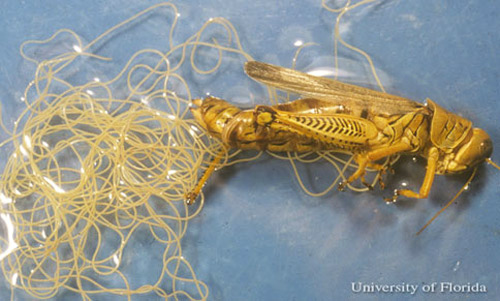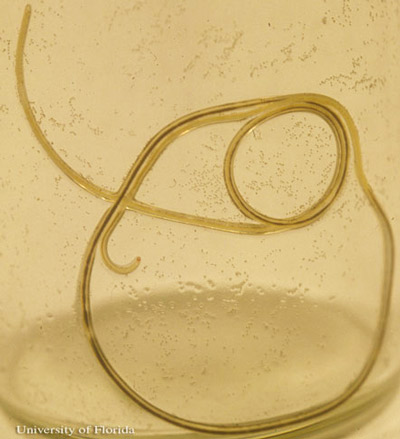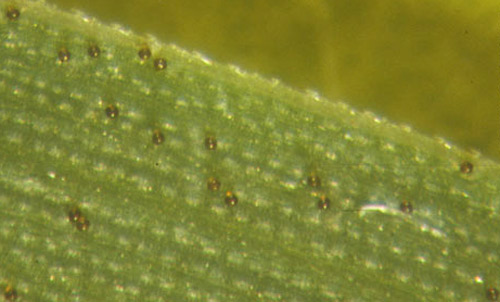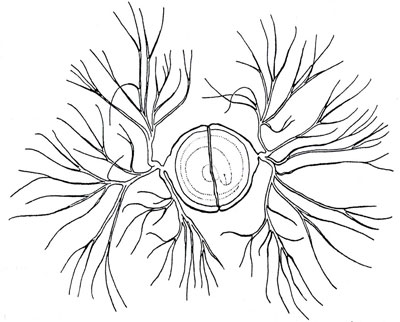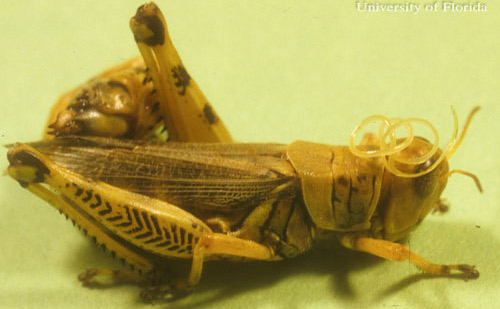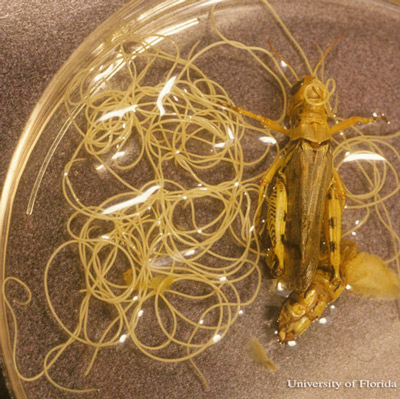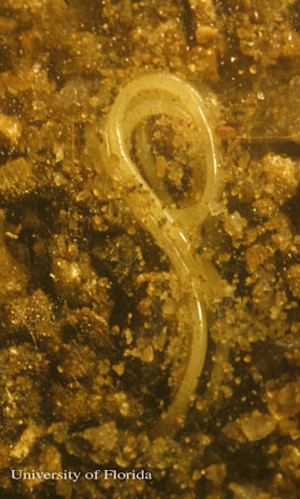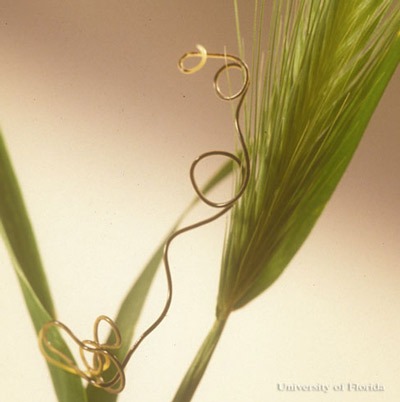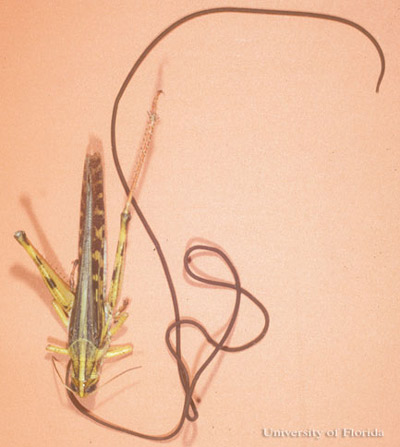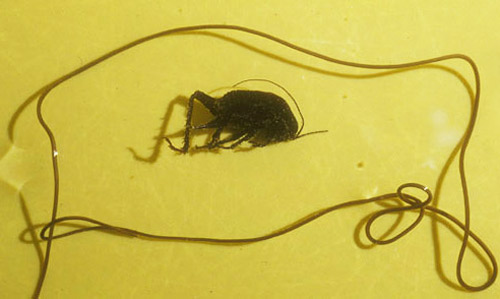common name: grasshopper nematode
scientific name: Mermis nigrescens Dujardin, 1842 (Phylum Nematoda, order Mermithida, family Mermithidae)
Introduction - Distribution - Life Cycle and Description - Identifiction - Hosts - Importance - Selected References
Introduction (Back to Top)
Mermis nigrescens Dujardin are relatively large nematodes sometimes seen leaving grasshoppers, especially those that have been injured. On rainy mornings in spring or summer these same nematodes can be found on foliage, where they are depositing their eggs. Because they are so large (up to 160 mm or about 6 inches in length), they attract attention.
Figure 1. Mature juvenile grasshopper nematodes, Mermis nigrescens Dujardin, that have left the body of a grasshopper. Photograph by John Capinera, University of Florida.
Distribution (Back to Top)
Mermis nigrescens occurs widely in North and South America, Europe and Asia. including the island of Tasmania. However, it is not yet found in continental Australia, though other Mermis spp. and related genera occur there, and can be quite important in population regulation of some grasshoppers. Distribution in Africa seems to be quite limited, but uncertain (Baker and Capinera 1997).
Life Cycle and Description (Back to Top)
So far as is known, among nematodes only Mermis spp. deposit their eggs on vegetation to be eaten by herbivorous insects; other mermithids deposit their eggs in the soil and when they hatch the larvae move to the surface and penetrate the hosts. After ingestion, the Mermis nigrescens eggs quickly hatch and the immature nematodes break through the gut wall and enter the body cavity of the host insect. Juvenile Mermis nigrescens development time is proportional to host size, but inversely proportional to the number of parasites in the host, and to temperature. Infection by Mermis nigrescens inhibits development of the ovaries in grasshoppers, and the host may perish before or after the nematodes emerge from the insect. After emerging, the nematodes enter the soil where they reach the adult stage after two to four months. They are not sexually mature for another six months, and may remain in the soil for up to three years, though a two-year life cycle is normal. Mermis nigrescens may either mate or reproduce parthenogenetically (Christie 1937).
Figure 2. Adult female grasshopper nematode, Mermis nigrescens Dujardin, in a vial. Note the numerous minute eggs adhering to the sides of the vial. Also notice the dark line of eggs within the adult's body. Photograph by John Capinera, University of Florida.
Eggs: Females typically emerge from the soil to deposit eggs in the spring, which is June in many temperate areas of the Northern Hemisphere. Although the adults may be active at night, eggs are produced only in the presence of sunlight. The eggs are quite small, about 0.05 mm in diameter. They are heavily pigmented and brown or reddish brown in color; this dark coloration protects them from ultraviolet light and extends their viability. The eggs are slightly constricted in the middle, and bear two clusters of branched filaments called byssi, one at each pole. As rainfall and dew evaporate, the filaments adhere to the foliage, causing the egg to remain fixed to the vegetation, where it can be consumed along with the plant. Irrigation can increase nematode parasitism of grasshoppers by simulating rainfall conditions. As noted previously, rainfall normally is a prerequisite for females to leave the soil to oviposit.
Figure 3. Eggs of the grasshopper nematode, Mermis nigrescens Dujardin, adhering to grass foliage. The eggs are consumed along with the vegetation when grasshoppers feed. Photograph by John Capinera, University of Florida
Figure 4. Diagram of Mermis nigrescens egg, showing byssi (adapted from Nickle 1971).
Juveniles: Eggs hatch within as little as one hour of being ingested by an insect. The immature nematodes use their stylet to penetrate the gut wall and enter the body cavity (hemocoel). Once inside the body cavity the second and third larval stages float in the blood and secure nutrients at the expense of the host insect (Burr et al. 1990). Baylis (1947) reported that the larvae were 0.24 mm long at hatching, increasing to 0.25–0.33 mm after 9 days, then 1.2–1.5 mm about day 11, 5.6 mm about day 20, 25 mm about day 32, and about 50 mm at day 37. Individual insects may ingest many nematode eggs over the course of their development, so it is not unusual to find insects with several or even hundreds of nematodes contained within their body, and sometimes at different stages of development. Consumption of too many eggs can result in premature death of the host, preventing successful development of the nematodes.
In a field study in Michigan, however, Bland (1976) found that male Melanoplus femurrubrum grasshoppers harbored an average of 1.2 nemas per host, and the larger females harbored an average of 4 per host. He also observed that the number of nematodes per host increased as the season (age of the grasshoppers) progressed. The body of juvenile nematodes is slightly tapered at both the anterior and posterior ends. Juvenile females typically remain in the host for for up to 10 weeks, then escape the host insect, killing it during the process of exiting. Once they leave the host they burrow into the soil, often to a depth of 15–45 cm. The juveniles remain in the soil in the immature form, molting to adults in the spring.
The size of the host insect greatly influences the nematode parasites (Craig and Webster 1982). Nematodes tend to grow faster and become larger if they develop in larger hosts. Sex ratio of the nematodes is affected, with a higher proportion of males developing in smaller hosts. The proportion of nematode larvae surviving to maturity also increased with host size.
Figure 5. Mature juvenile grasshopper nematodes, Mermis nigrescens Dujardin, emerging from a grasshopper. Photograph by John Capinera, University of Florida.
Figure 6. Mature juvenile grasshopper nematodes, Mermis nigrescens Dujardin, that have left the body of a grasshopper. Photograph by John Capinera, University of Florida.
Figure 7. Mature juvenile grasshopper nematode, Mermis nigrescens Dujardin, that has descended into the soil after exiting a grasshopper. Photograph by John Capinera, University of Florida.
Adults: Adults mate in the spring or summer following their descent into the soil, but females remain there through the summer, fall and winter while their eggs mature. It is only in the third spring or summer of their existence that the females emerge to deposit new eggs. Thus, the life cycle is two years in duration, but occurs over three calendar years. Males are shorter lived than females, perishing after they mate. Males are about 40–60 mm long, females 60–160 mm. Females with fully developed eggs come to the surface and oviposit on vegetation only following protracted rainfall, often in the morning hours before the sun dries the foliage. They are photopositive while searching for suitable oviposition sites, and will climb to heights of 2–3 m if there is persistent rainfall (Burr et al. 1990). Females produce large quantities of eggs, estimated to be up to 14,000 per female. When laden with eggs, the females appear to have a dark stripe running the length of the body, but this dark coloration is due to the presence of numerous eggs in the body of the female, and the dark coloration disappears as the eggs are deposited. As is the case with other nematodes, locomotion results from posteriorly propagated body waves. However, unlike other nematodes, contact with the substrate by the female once she leaves the soil is limited to the female's ventral surface. In many respects, this nematode moves like a snake.
Figure 8. Adult female grasshopper nematode, Mermis nigrescens Dujardin, climbing vegetation in preparation for depositing eggs. Photograph by John Capinera, University of Florida.
Identification (Back to Top)
Mermis and related nematodes are often confused with horsehair worms (Nematomorpha: Gordioidea). Horsehair worms superficially resemble Mermis nigrescens nematodes, but horsehair worms may be twice as long, and often are found near water. Horsehair worms typically are completely dark in color, with a uniform thickness throughout almost the entire length of the body. Mermis nigrescens nematodes are not uniformly dark and at least one end of the body tapers to a blunt point. Identification aids can be found in Nickle (1971, 1973) and Baker and Capinera (1997).
Figure 9. Horsehair worm, Gordius sp. that has emerged from a grasshopper. Photograph by John Capinera, University of Florida.
Figure 10. Horsehair worm, Gordius sp. that has emerged from a cricket. Photograph by John Capinera, University of Florida.
Hosts (Back to Top)
Mermis nigrescens is normally associated with grasshoppers (Orthoptera: Acrididae, Romaleidae, Tettigoniidae) but also is reported to occur naturally in earwigs (Dermaptera), beetles (Coleoptera), caterpillars (Lepidoptera), and even honeybees (Hymenoptera) (Capinera 1987, Poinar 1979). Because it is similar in appearance to other species of Mermis, and to Amphimermis, Longimermis, Agamermis, and Hexamermis, some host records may be inaccurate.
Importance (Back to Top)
The occurrence of Mermis nematodes is unquestionably related to the occurrence of favorable hosts, but due to the protracted development period of the nematode the relationship can best be described as delayed density-dependent. Various studies have reported high levels of parasitism in grasshoppers: up to 76% of Melanoplus bivittatus in Vermont, 71% of Melanoplus femurrubrum in Michigan, 70% in Hesperotettix viridis in North Dakota, 22% of Melanoplus nymphs in Indiana, 36% in Melanoplus sanguinipes in Manitoba, and up to 43% of mixed populations in Quebec. Although often considered to be absent from arid areas such as the western Great Plains of the United States, they do occur where water is available. In Colorado, up to 50% of Melanoplus femurrubrum was found to be infected from irrigated cropland, whereas the same species was unparasitized in nearby arid rangeland (Capinera 1987). Although claims sometimes are made about the suppressive effects on grasshopper populations by Mermis nigrescens, their long life cycle and need for high moisture conditions reduce their reliability as a biological control agent.
Mermis nigrescens is not available commercially. However, their egg stage is fairly light and desiccation resistant, can be stored for a year or more, and can be applied as a suspension in water. If an economical artificial rearing technique could be developed, Mermis nigrescens might make a useful augmentative biological control tool or bio-insecticide.
Selected References (Back to Top)
- Baker GL, Capinera JL. 1997. Nematodes and nematomorphs as control agents of grasshoppers and locusts. Memoirs of the Entomological Society of Canada 171: 157-211.
- Baylis HA. 1944. Observations on the nematode Mermis nigrescens and related species. Parasitology 36: 122-132.
- Baylis HA. 1947. The larval stages of the nematode Mermis nigrescens. Parasitology 38: 10-16.
- Bland RG. 1976. Effect of parasites and food plants on the stability of a population of Melanoplus femurrubrum. Environmental Entomology 5: 724-728.
- Briand LJ, Rivard I. 1964. Observations sur Mermis subnigrescens Cobb (Mermithidae), nematode parasite des criquets au Québec. Phytoprotection 45: 73-76.
- Burr AHJ, Babinski CPF, Ward AJ. 1990. Components of phototaxis of the nematode Mermis nigrescens. Journal of Comparative Physiology A. Sensory, Neural, and Behavioral Physiology 167: 245-255.
- Capinera JL. 1987. Observations on natural and experimental parasitism of insects by Mermis nigrescens Dujardin (Nematoda: Mermithidae). Journal of the Kansas Entomological Society 60: 159-162.
- Christie JR. 1937. Mermis subnigrescens, a nematode parasite of grasshoppers. Journal of Agricultural Research 55: 353-364.
- Craig SM, Webster JM. 1982. Influence of host nutrients on the parasitic development of Mermis nigrescens (Mermithidae). Journal of Nematology 14: 398-405.
- Gans C, Burr AHJ. 1994. Unique locomotory mechanism of Mermis nigrescens, a large nematode that crawls over soil and climbs through vegetation. Journal of Morphology 222: 133-148.
- Mongkolkiti S, Hosford RM Jr. 1971. Biological control of the grasshopper Hesperotettix viridis pratensis by the nematode Mermis nigrescens. Journal of Nematology 3: 356-363.
- Nickle WR. 1971. A contribution to our knowledge of the Mermithidae (Nematoda). Journal of Nematology 4: 113-146.
- Nickle WR. 1973. Identification of insect parasitic nematodes - a review. Experimental Parasitology 33: 303-317.
- Poinar GO Jr. 1979. Nematodes for biological control of insects. CRC Press, Boca Raton, FL.
- Webster JM, Thong CHS. Nematode parasites of orthopterans. Pages 697-726 In Nickle WR (editor) Plant and insect nematodes. Marcel Dekker, Inc., New York.
